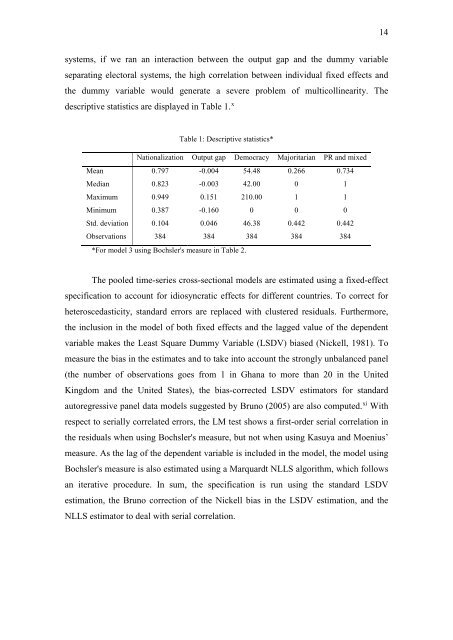AN ECONOMIC EXPLANATION OF THE NATIONALIZATION OF ELECTORAL POLITICS
n?u=RePEc:gov:wpaper:1602&r=fdg
n?u=RePEc:gov:wpaper:1602&r=fdg
You also want an ePaper? Increase the reach of your titles
YUMPU automatically turns print PDFs into web optimized ePapers that Google loves.
14<br />
systems, if we ran an interaction between the output gap and the dummy variable<br />
separating electoral systems, the high correlation between individual fixed effects and<br />
the dummy variable would generate a severe problem of multicollinearity. The<br />
descriptive statistics are displayed in Table 1. x<br />
Table 1: Descriptive statistics*<br />
Nationalization Output gap Democracy Majoritarian PR and mixed<br />
Mean 0.797 -0.004 54.48 0.266 0.734<br />
Median 0.823 -0.003 42.00 0 1<br />
Maximum 0.949 0.151 210.00 1 1<br />
Minimum 0.387 -0.160 0 0 0<br />
Std. deviation 0.104 0.046 46.38 0.442 0.442<br />
Observations 384 384 384 384 384<br />
*For model 3 using Bochsler's measure in Table 2.<br />
The pooled time-series cross-sectional models are estimated using a fixed-effect<br />
specification to account for idiosyncratic effects for different countries. To correct for<br />
heteroscedasticity, standard errors are replaced with clustered residuals. Furthermore,<br />
the inclusion in the model of both fixed effects and the lagged value of the dependent<br />
variable makes the Least Square Dummy Variable (LSDV) biased (Nickell, 1981). To<br />
measure the bias in the estimates and to take into account the strongly unbalanced panel<br />
(the number of observations goes from 1 in Ghana to more than 20 in the United<br />
Kingdom and the United States), the bias-corrected LSDV estimators for standard<br />
autoregressive panel data models suggested by Bruno (2005) are also computed. xi With<br />
respect to serially correlated errors, the LM test shows a first-order serial correlation in<br />
the residuals when using Bochsler's measure, but not when using Kasuya and Moenius’<br />
measure. As the lag of the dependent variable is included in the model, the model using<br />
Bochsler's measure is also estimated using a Marquardt NLLS algorithm, which follows<br />
an iterative procedure. In sum, the specification is run using the standard LSDV<br />
estimation, the Bruno correction of the Nickell bias in the LSDV estimation, and the<br />
NLLS estimator to deal with serial correlation.


